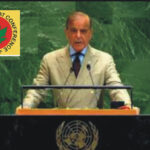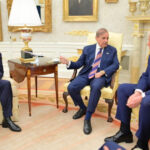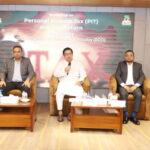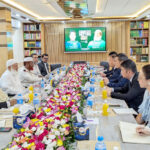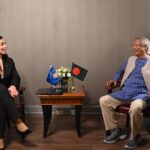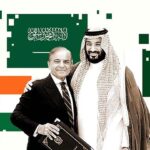
INSIDE RUSSIA
The US tech firm scaled down operations in the country in 2022 and was hit by lawsuits
One of Microsoft’s Russian subsidiaries has announced plans to file for bankruptcy, according to a note published on the official Fedresurs registry on Friday. The US-based tech giant opted to exit the country shortly after the escalation of the conflict in Ukraine.
In March 2022, the corporation stopped selling its products and services in Russia, pausing other aspects of its business in the country to comply with sanctions introduced by the West against Moscow amid the Ukraine conflict.
Since then, a wide range of Russian corporate giants – including Severstal, Uralkali, VTB, MegaFon, Gazprombank, and others – have filed lawsuits against the company’s local subsidiary, Microsoft Rus. The total value of the suits related to breach of contractual obligations after the exit amounts to 341 million rubles (nearly $3.6 million), according to the Russian business daily RBK.
Shortly after pulling the plug on operations in Russia, the company stopped renewing Microsoft 365 subscriptions—including Outlook, Teams, Office, OneDrive, and SharePoint services—for its corporate clients, disconnected a number of Russian organizations from cloud services such as Visio Online, Project Online, and Power BI, and introduced other restrictions.
According to data tracked by RBK, the revenue of Microsoft’s Russian subsidiary last year amounted to 161.6 million rubles (nearly $2 million), with net profit totaling 174.1 million rubles ($2.13 million). The data shows the company reported revenue of 6.9 billion rubles ($84.5 million) and a profit of 638.1 million rubles ($7.8 million) in 2021, which marked its last full year of operations in Russia before deciding to quit.
Earlier this year, the multinational registered the trademark ‘Microsoft Places’ with the Russian patent office, Rospatent. According to the filing card, the company plans to provide or grant temporary access to “downloadable computer software for managing hybrid planning, workplace management, office space management,” and other types of software until 2023.
In recent months, foreign corporations—including McDonald’s, Hyundai, Intel, LG, IKEA, Chanel, Rolex, and Louis Vuitton—that had previously exited Russia have begun registering new trademarks in the country, signaling their potential return.
Earlier this week, Russian President Vladimir Putin urged the creation of a program for foreign corporations willing to return to the Russian market, “but only insofar as it aligns with the protection of our own business interests.” Speaking with business leaders in the Kremlin, the president emphasized that Moscow won’t be “rolling out a red carpet” for McDonald’s and other companies.
FACTBOX: What is known about the train derailment in Bryansk Region
TASS has assembled the main facts about the incident
MOSCOW, June 1. /TASS/. A passenger train derailed as a result of a bridge collapse in the Vygonichsky District of the Bryansk Region. Seven people were killed and 33 were injured.
TASS has assembled the main facts about the incident.
Circumstances of the emergency
– Information about the collapse of the road bridge structure was received at 10:50 p.m. Moscow time on May 31, the Western Interregional Investigative Department for Transport of the Investigative Committee of Russia reported.
– The collapse occurred as a result of interference with transport operations, the press service of the Moscow Railway said.
– Passenger train No. 86 Klimov – Moscow derailed on the single-track Pilshino-Vygonich section.
– An operational headquarters has been set up at the Situation Center of the Russian Transport Ministry to coordinate actions with Russian Railways and the Emergency Situations Ministry.
– Recovery trains have been sent to the scene.
Dead and injured
– Seven people have died and 33 have been injured.
– According to Bryansk Region Governor Alexander Bogomaz, 30 people have been taken to hospitals.
– Two of the injured, including a child, are in serious condition.
Consequences
– The Moscow Interregional Transport Prosecutor’s Office has launched an investigation.
– Investigators are working at the scene.
– A temporary accommodation center has been set up at the Vygonichskaya School.
– The train passengers have been evacuated to a temporary accommodation center at the Vygonich station, Russian Railways reported.
– A reserve Bryansk-Moscow train has been set up for passengers.
‘Digital Industry of Industrial Russia’ Conference to Kick Off on June 2
From June 2 to 8, the 10th Digital Industry of Industrial Russia (CIPR) conference will be held in Nizhny Novgorod.
CIPR is the most authoritative discussion platform for dialogue between business and government representatives aimed at developing Russia’s IT industry into a global technology leader.
At this milestone tenth conference, participants will analyze previously adopted digitalization decisions, consolidate achievements, and define the country’s development path for the coming decade.
The 2025 conference will feature the following events:
June 2–5, the main event of CIPR-2025: Leading experts and industry leaders will discuss digital transformation across society and key economic sectors, with six major thematic tracks — ‘Data Economy’, ‘Business’, ‘Tech Leadership’, ‘Cybersecurity’, ‘Human Capital’, ‘Black’ — plus a special AI-focused track.
CIPR2025 by the numbers:
- 10,500 participants
- 5,000 IT companies
- 170 partners
- 16 countries
- 8,700 m² of exhibition space
- 120 business sessions
- 800 speakers
Special focus will be given to expanding international cooperation with BRICS, EAEU, and SCO countries. Sessions are being organized in partnership with the Shanghai Cooperation Organization and the United Nations Industrial Development Organization.
Participants will discuss mutually beneficial cooperation in the global market, tools for advancing tech projects and digital ecosystems, and collaboration in AI and smart city governance.
June 3: The CIPR Digital-2025 Awards ceremony will recognize and promote the best Russian IT projects and innovations.
June 5–6: The first Global Digital Forum will take place, offering participants insight into Russia’s IT achievements, global trends, digital partnership opportunities, and business deal-making.
Representatives from Niger, Congo, Malawi, Cameroon, Bosnia and Herzegovina, Serbia, South Ossetia, Senegal, Afghanistan, Ethiopia, Bahrain, the Union of the Comoros, and other participating countries will attend.
About the Global Digital Forum:
- 2,367 on-site IT experts
- 10,000 IT experts online
- 170 companies at IT-EXPO
- 116 participating countries
- 8,000 m² of exhibition space
The forum program includes three key tracks:
- Educational Track – workshops on countering disinformation, cybersecurity practical lectures, interactive modules on testing and protecting critical information infrastructure.
- Protocol Track – over 100 agreements, MOUs, and IT deals to be signed.
- Business Track – high-level plenary sessions, expert panels, and roundtables on digital trends and challenges and how to address them.
June 5–8: The Tech-Friendly Weekend will showcase how small and medium-sized businesses and creative industries are evolving in response to new technologies and digitalization.
The main theme will be ‘Artificial Intelligence’. The festival will bring together those who train neural networks, integrate AI into business, and test its real-world applications.
OUTSIDE RUSSIA
Kremlin speaks out on Macron slap
“Not our business,” spokesman Dmitry Peskov said commenting on a video showing France’s first lady shoving her husband on a plane
Kremlin spokesman Dmitry Peskov was reluctant to comment on French President Emmanuel Macron being pushed in the face by his spouse Brigitte, saying it was unacceptable to talk about such family issues. However, he went on to point out that a wife always has a reason to slap her husband.
The footage of the incident was captured as the French first couple arrived in Hanoi, Vietnam, on May 25. The video shows the aircraft door opening to reveal Macron speaking to someone off-camera. Moments later, two arms in red sleeves reach out and push his face, covering his mouth and jaw. Macron steps back, smiles, and waves after noticing the cameras. Brigitte soon appears beside him, wearing a red jacket.
The video later went viral, prompting the president to downplay the incident, describing it as the two of them just “bickering and joking.”
“You know, I am convinced that it would be inappropriate for us to comment on the Macron family’s private matters,” Peskov said. “On the other hand, if a wife slaps her husband, she never does it without a reason, but still, it’s not our business.”
Shifting away from celebrity gossip, the spokesman emphasized that Paris isn’t working towards peace, and opting to increase pressure on Moscow instead.
“France still believes that something can be achieved with Russia through pressure — this reflects a fundamental misunderstanding of the nature of our country,” Peskov said, adding that the fact that the French leader “does not understand the reality of the situation” is regrettable.
France has provided over €3.8 billion ($4.2 billion) in military aid to Kiev since the escalation of the Ukraine conflict in February 2022, according to the Kiel Institute.
Authorities in Paris have advocated deploying French troops to Ukraine in the event of a peace deal between Kiev and Moscow, arguing that it could help deter Russia. In March, Macron announced a French-British plan to prepare such a “reassurance force” in the event of a ceasefire. The announcement sparked protests in Paris against what demonstrators called NATO’s militaristic stance.
Russia has repeatedly warned it won’t accept the presence of any NATO country’s troops in Ukraine, and pointed out that the military bloc’s expansion in Europe had been a primary reason for the conflict.
Medvedev predicts collapse of Germany’s economy due to stupid policies
That is what Russian Security Council Deputy Chairman said, commenting on German Foreign Minister Johann Wadephul’s interview with the SueddeutscheZeitung newspaper
MOSCOW, May 31. /TASS/. Berlin’s short-sighted policies could lead to the collapse of Germany’s economy, Russian Security Council Deputy Chairman Dmitry Medvedev warned on the X social media platform.
Commenting on German Foreign Minister Johann Wadephul’s interview with the SueddeutscheZeitung newspaper, Medvedev said: “A ghoul called Wadephul says he no longer expects Russia’s complete defeat due to its nuclear arsenal. We are eagerly expecting Germany’s economic collapse due to its stupid policies though.”
In his interview, the top German diplomat suggested that the Ukraine conflict would be resolved through talks because Russia, a nuclear power, was not expected “to face a complete defeat and surrender.”.
SPECIAL MILITARY OPERATION IN UKRAINE
Russian troops take almost all crucial Kiev forces facilities in Stupochki in DPR — expert
“We have captured almost all strategically important facilities there and now we are clearing out the outskirts,” AndreyMarochko said
LUGANSK, June 1. /TASS/. Russian units have captured almost all important Ukrainian armed forces facilities in Stupochki in the People’s Republic of Donetsk and are clearing out the village’s outskirts, military expert AndreyMarochko told TASS.
“Our servicemen have made great strides this week in the village of Stupochki – serious progress [has been made] in this village. We have captured almost all strategically important [Ukrainian armed forces] facilities there and now we are clearing out the outskirts,” he said.
Marochko noted that in general, Russian fighters have “achieved significant results” in Stupochki over the week, but they need to clear out a number of outskirts, since Ukrainian militants are conducting counterattacks and trying to regain previously lost positions.
Russian forces liberate Sumy Region’s Vodolagi, DPR’s Novopol — top brass
The military also pointed out that Russian air defenses downed 169 Ukrainian fixed-wing drones over the past 24 hours
MOSCOW, May 31. /TASS/. Russian servicemen have liberated Vodolagi in the Sumy Region and Novopol in the Donetsk People’s Republic, the Defense Ministry reported.
“The battlegroupNorth liberated the village of Vodolagi in the Sumy Region. <…>Thebattlegroup East liberated the village of Novopol in the Donetsk People’s Republic,” the statement said.
The ministry also reported that the Ukrainian armed forces had lost up to 1,425 troops, two tanks, and 18 armored vehicles over the past 24 hours. According to its statement, the battlegroupNorth eliminated over 225 enemy servicemen and destroyed two tanks and four armored vehicles. The battlegroupWest wiped out over 270 Ukrainian troops and liquidated five armored vehicles. The battlegroup South eliminated up to 275 enemy servicemen and destroyed two armored vehicles. The battlegroup Center wiped out up to 440 Ukrainian troops and annihilated five armored vehicles. The battlegroupEast eliminated up to 185 enemy servicemen and destroyed two armored vehicles, whereas the battlegroup Dnepr wiped out over 80 troops.
The military also pointed out that Russian air defenses downed 169 Ukrainian fixed-wing drones over the past 24 hours.
In addition, the Russian Armed Forces destroyed two Ukrainian HIMARS launchers in the Sumy Region with an Iskander missile strike. Overall, Russian servicemen hit Ukrainian strike drone production facilities and storage sites, as well as temporary deployment sites in 147 areas over the past 24 hours.
“The Russian Armed Forces destroyed warehouses containing missile and artillery weapons, as well as ammunition and fuel depots and workshops for producing strike drones. Russian servicemen also destroyed storage sites and Ukrainian temporary deployment sites in 147 areas,” the statement said.
Russia Ready to Continue, Escalate Military Op in Ukraine ‘For as Long as It Takes’ – Envoy to UN
The goals of Russia’s operation in Ukraine can be achieved not just by diplomacy but through military means as well, warned Russian Ambassador to the UN VassilyNebenzia.
“The Russian Armed Forces can continue and ramp up military operations for as long as it takes,” he said.
Ceasefire Issue
A ceasefire is not enough to bring the conflict between Russia and Ukraine to a sustainable end, Nebenzia said.
“A simple ceasefire is not enough to achieve this [sustainable end of the conflict]. We already once stood at this very crossroads in the context of the Minsk agreements, which were systematically violated by the Western Ukraine,” Nebenzia told the UN Security Council.
Russia is ready to “in principle” agree to a ceasefire with Ukraine, but it also wants Kiev to take steps in this direction, he added.
“In principle, we are prepared to consider the possibility of establishing a ceasefire, which would then, in the future, pave the way for a lasting settlement to the root causes of the conflict. In order to achieve this, however, we need to see the other party taking steps as well,” Nebenzia told the UN Security Council.
A Warning to Germany
If Germany provides its Taurus missiles to Ukraine, getting directly involved in the conflict, it will give Russia the right to “consider all options” to “properly” respond to such a move, Nebenzia told the UN Security Council.
“Germany is going to be drawn further into a war with Russia through these actions [providing Taurus missiles], which will give us the right to consider all options so as to properly respond to this unfriendly step. If there is any common sense left in Berlin, if there are still people there who have not forgotten history, they cannot but understand what these new aggressive actions of Germany against Russia will result in,” he explained.
German Chancellor Friedrich Merz is not able to fool anyone with his speeches, and Berlin may be drawn into a conflict with Moscow if its policy remains the same, Nebenziasaid .
“Afterwards, the German leader did try to backtrack and started to say that Germany was in fact going to help Ukraine to independently produce long-range missiles. Without a doubt, these clumsy maneuvering didn’t fool anybody,” he elaborated.
If Berlin has any common sense left, they should understand possible dire consequences of such actions, the diplomat added.
“Germany is going to be drawn further into a war with Russia through these actions, which will give us the right to consider all options so as to properly respond to this unfriendly step,” Nebenzia said.
Zelensky’s Greatest Fear
VolodymyrZelenskyy does not want the Ukraine conflict to come to an end as he will face a lot of accountability for his actions, Nebenzia said.
“If this happens, he’ll have to hold elections and answer before his electorate for what he turned Ukraine into over the last six years, as well as answer for the hundreds of billions of state funds, which he has stolen, and he’ll have to answer to the West, first and foremost, to the Americans for the aid he received,” he continued.
The second major reason for why the Ukraine conflict is still dragging on is European warmongers, who are trying to keep Washington stuck in the conflict, the ambassador added.
INSIGHTS
What is Trump’s game in Syria?
Why has the US president decided to lift all sanctions on Damascus, and how will it shape the future of the region?
US President Donald Trump’s recent announcement that he intends to lift all sanctions on Syria stands as one of the most unexpected and controversial foreign policy moves Washington has made in the past decade.
Declared during Trump’s Middle East tour at the US-Saudi Investment Forum in Riyadh, the decision marks a dramatic shift in America’s approach to the region – one that could reshape the strategic landscape for both allies and adversaries.
The sanctions on Syria, first imposed in 1979, were progressively tightened over decades in response to accusations of sponsoring terrorism, human rights abuses, and close ties with Iran. Their full repeal is an unprecedented gesture, especially considering that Syria’s current president, Ahmed Hussein al-Sharaa, was until recently regarded by the US as a senior figure in Al-Qaeda – with a $10 million bounty once placed on his capture.
In return, Damascus has made a series of strategic commitments. According to Trump, al-Sharaa has pledged to prevent the resurgence of Islamic State (IS, formerly ISIS), bring all jihadist detention camps under state control, and expel all foreign terrorist formations from Syrian soil. This latter promise is particularly significant, as these militant units – many of them composed of fighters from Central Asia – played a pivotal role in the collapse of Bashar Assad’s regime and the rise of the current leadership.
Many of these same groups are also responsible for large-scale ethnic purges, including the massacres of Alawites and other religious minorities earlier this year. Thus, Trump’s proposal does more than legitimize al-Sharaa’s regime – it places on it the mantle of a regional stabilizer, albeit one whose legitimacy remains heavily disputed.
The decision to lift sanctions cannot be divorced from Washington’s broader economic and strategic interests. That the announcement came in Saudi Arabia is no coincidence – it signals a broader understanding with Riyadh, which is eager to deepen its footprint in post-conflict Syria. From the US perspective, the Syria deal is a building block in a new Middle Eastern architecture – one dominated by pro-Western governments and designed to neutralize Iranian influence.
Saudi Arabia and the United Arab Emirates have long viewed Syria’s reconstruction as an opportunity to entrench themselves politically and economically. US sanctions had previously prevented them from acting overtly, and the lifting of restrictions may now be part of a grander bargain: Riyadh receives a green light to invest in Syria, while Washington secures massive financial commitments. On May 14 – the day of Trump’s announcement – Saudi Arabia signed a $142 billion arms deal with the US and pledged an additional $600 billion in American investments.
At first glance, Trump’s move might appear as a betrayal of Israeli interests – an accusation made in several media commentaries. Yet in practice, Israel gains a neighbor that, while unpredictable, is now positioned to suppress Islamist radicals within its borders. This allows it to refocus on countering Iran and Hezbollah without the added distraction of threats emanating from Syria.
The lifting of sanctions also aligns with Türkiye’s strategic goals. President Erdogan, just prior to the Trump-al-Sharaa meeting, personally urged the US president to dismantle the sanctions. Türkiye is a key partner of Syria’s new leadership but has been constrained by its own economic crisis. Moreover, the sanctions hindered Ankara’s allies – particularly Qatar – from taking part in Syria’s postwar reconstruction.
In sum, Trump’s Syrian deal represents more than just a diplomatic maneuver; it is a bold attempt to reengineer the regional balance of power. Whether it brings long-term stability or fuels new fault lines remains to be seen – but its impact on the Middle East is already unmistakable.
What lies behind this move?
The developments unfolding in Syria following the rise to power of Ahmed al-Sharaa increasingly evoke the atmosphere of 2011 – the era of the Arab Spring, when the Middle East fractured into two ideological and geopolitical camps. At the time, Türkiye and Qatar actively championed the cause of ‘political Islam’, seeking to expand their influence through the emergence of Islamist-oriented governments. In contrast, Saudi Arabia and the United Arab Emirates perceived Islamist forces as a direct threat to regional stability and the survival of their monarchical order.
Today, under al-Sharaa’s leadership, Syria once again reflects that same fault line. A sense of déjà vu looms: The region’s main players find themselves navigating renewed tensions, caught between the desire to preserve influence and the necessity of adapting to a rapidly evolving reality.
Ankara and Doha, both instrumental in al-Sharaa’s ascent, view his leadership as an opportunity to reclaim their diminished standing in the Levant. Despite its internal economic turmoil, Türkiye continues to position itself as a regional arbiter, relying on a network of loyal political and military actors within Syria. Qatar, for its part, is providing financial and diplomatic support, effectively replicating the strategy it previously deployed in Libya, Egypt, and Tunisia.
Yet the current landscape differs markedly from that of 2011. Al-Sharaa, though buoyed by Turkish support, has signaled a desire for greater autonomy from the outset. His first official foreign visit was not to Ankara, but to Riyadh – a symbolic gesture toward Saudi Arabia and the UAE, whose economic power is now essential for Syria’s reconstruction. It was also a clear signal that Damascus is open to dialogue, even with those who once backed the opposing side in the civil war.
For Saudi Arabia and the UAE, the resurgence of politically motivated Islamist forces is a source of deep concern, though their response has remained deliberately muted. Rather than overt confrontation, these Gulf monarchies have opted for economic engagement, believing that financial leverage will grant them influence while curbing radicalization.
They also see the new Syrian leadership as a potential partner in shaping a new Middle Eastern order – provided that Damascus does not become an instrument of Turkish expansionism. This explains al-Sharaa’s active display of ‘independent maneuvering’, as he skillfully balances between centers of power – from the Gulf to Ankara, from Washington to Moscow.
Amid this geopolitical mosaic, the US has crafted a new strategic vision. Under Trump’s leadership, US policy increasingly focuses on economic leverage and security cooperation while moving away from direct military engagement in the Middle East. Trump proposes a new model: ‘Regional self-sufficiency’ under an American umbrella.
The essence of this model is to arm and equip regional actors, enabling them to maintain stability independently, with the US acting as a supplier of advanced technology and a guarantor of balance. In return, Washington demands loyalty, political restraint, and – crucially – substantial financial contributions. This underpins the strategic alignment with Gulf monarchies, who possess the means and motivation to counterbalance Iran.
At the same time, Trump is attempting to bridge the divide between Türkiye and Israel, laying the groundwork for an economic partnership despite ideological differences. The goal is to prevent friction among US allies and to forge a unified front against Iran and other hostile forces.
Syria, in this context, becomes a testing ground for America’s new security architecture – a controlled regional equilibrium maintained without the Pentagon’s direct footprint. If successful, this model could be replicated in other crisis zones.
A potential next step is the normalization of relations between Syria and Israel – a previously unimaginable prospect, now discussed as part of a broader settlement. In parallel, Trump plans to introduce a new Middle East peace framework that includes recognition of Palestine in exchange for diplomatic and economic incentives from Arab states. This scenario may also presage political change in Israel: If Prime Minister Benjamin Netanyahu resists the plan, centrist alternatives like YairLapid or Benny Gantz – more amenable to compromise – could come to the fore.
All of this unfolds against the backdrop of a fundamental reordering of US global priorities. Washington is increasingly pivoting toward the containment of China, its primary strategic rival in the 21st century. The Middle East is no longer seen as a vital sphere; the new approach favors balance over expansion, mediation over presence, partnership over intervention.
Thus, US regional strategy is evolving from rigid control to a more adaptive configuration – one in which local actors are granted greater autonomy, though still within an overarching framework engineered in Washington. Syria may well serve as the first case study of this new era – an era in which the return to the logic of 2011 unexpectedly becomes the launchpad for a very different Middle East.
Will things get better in Syria?
The US decision to lift sanctions on Syria following the rise of al-Sharaa to power marks a pivotal moment for a country that has endured over a decade of devastating war, international isolation, and socioeconomic collapse.
This move not only removes one of the most significant external constraints on the Syrian leadership, but also opens a window of opportunity to construct a new model of governance – one grounded in pragmatism, economic rationality, and cautious multilateralism.
Al-Sharaa now faces a critical choice: To use this opportunity to consolidate centralized authority and restore effective governance – or, through missteps or weakness, to allow Syria to fragment further into a collection of ethno-regional entities devoid of a unifying national project.
The World Bank has cleared over $15 million of Syrian debt, once again making the country eligible for participation in international financing programs. This development was made possible through targeted financial contributions from the Gulf states – particularly Saudi Arabia and Qatar – signaling their intention to take the lead in Syria’s reconstruction. Following this, the IMF expressed its readiness to provide technical assistance, while the Syrian authorities issued a series of statements inviting investment in agriculture, energy, transportation infrastructure, and tourism.
These actions indicate the new regime’s ambition to craft an economic model that not only addresses the war’s legacy but also generates employment, stabilizes the currency, boosts public revenues, and – most importantly – restores public trust in the institution of the state.
However, economic recovery is only feasible if accompanied by the genuine restoration of governance.
Syria remains deeply fragmented. Kurdish regions in the northeast are governed by a de facto autonomous administration with its own armed forces and international channels. In the south, the Druze community in Suwayda exhibits growing political and organizational independence, alongside protest movements and local defense initiatives. Along the coastal regions – home to significant Alawite and Christian minorities – distrust toward centralized power continues to grow, especially amid persistent ethno-sectarian tensions. These communities, should the center weaken, may gravitate toward political separatism or at least self-organization into autonomous administrative structures.
If the al-Sharaa government fails to propose a coherent model of political integration – one that includes power-sharing, resource distribution, and the participation of regional elites in governance – Syria could enter a new phase of ‘soft disintegration’: A de facto federalization where unity is maintained in name only.
In this context, foreign policy becomes critically important. Fully aware of the dangers of unilateral alignment, Ahmed al-Sharaa is pursuing a balanced external strategy. Unlike the previous era, which was defined by dependence on a narrow circle of allies, Syria’s new president is embracing a diversified diplomatic approach. He seeks to build relations with the West and the US – especially in the context of economic recovery and Syria’s international rehabilitation – without abandoning existing strategic ties. It is within this framework that Russia remains a key partner to Syria across several strategic domains.
Russia continues to play a central role in Syria’s security architecture and diplomatic positioning, including defending Syrian interests at the UN Security Council and engaging in technical, military, and energy cooperation.
Its presence in Tartus and Khmeimim, involvement in humanitarian initiatives, and potential contributions to infrastructure reconstruction ensure its continued relevance in any long-term settlement scenario.
At the same time, Damascus under al-Sharaa is also looking to build stronger ties with other non-Western power centers – including China, India, and Brazil – while deepening economic engagement with the Arab world. This will help Syria avoid overdependence on any single actor and enhance its strategic flexibility amid global uncertainty.
This approach reflects a clear-eyed understanding of Syria’s geopolitical reality: The country can no longer afford to be part of rigid geopolitical axes. Its survival now depends on its ability to navigate between competing powers – leveraging their rivalry for national benefit without becoming anyone’s pawn. Maintaining cooperative relations with Russia and expanding dialogue with non-Western powers is not just a matter of foreign policy – it is a means of preserving autonomy in a context of limited sovereignty.
The lifting of sanctions and al-Sharaa’s ascent have opened a potential path toward stabilization. But the durability of this trajectory depends on the regime’s ability not only to harness economic resources but also to execute a complex, multi-layered political and diplomatic agenda. Domestically, this means launching mechanisms of integration and decentralization; externally, it requires deft maneuvering between Western and non-Western actors. In this evolving environment, Russia remains an important partner for Syria – not as an exclusive ally, but as a key component in the multifaceted diplomacy that al-Sharaa will seek to construct in order to reinforce not just his own authority, but the very foundations of the Syrian state.
